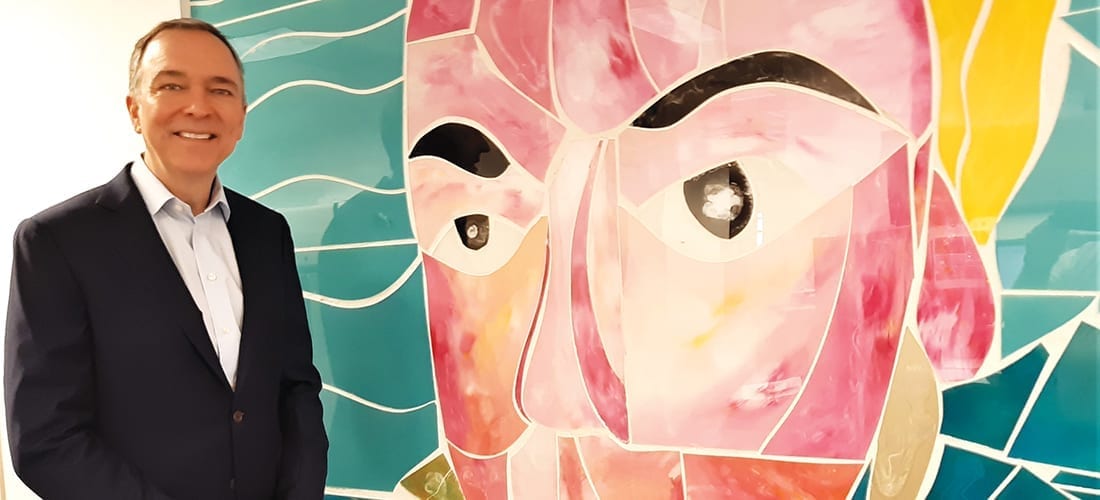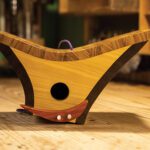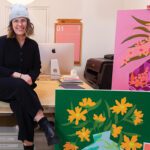Ally for the arts
December 2, 2019

Arts & Science Council President Jeep Bryant discusses his first impressions of Charlotte’s cultural scene and aspirations for the local arts sector.
by Michael J. Solender
Jeep Bryant is an especially accomplished listener.
That’s a good thing, as most everyone he’s met during the first few months in his new job as president of the Arts & Science Council has an opinion on Charlotte-Mecklenburg’s cultural landscape.
The “almost” Charlotte native — he moved here as a 1-year-old — returned to the Queen City in July after 20 years away. Following careers in communications and financial services, he most recently was director of marketing and business development for The Broadway League, the national trade association for the Broadway theater industry in New York City. Bryant, a graduate of South Mecklenburg High School (where he sang in the chorus) and UNC Chapel Hill, succeeded longtime ASC leader Robert Bush, who retired in June after five years in the post.
SouthPark magazine spoke with Bryant earlier this fall, prior to the November election in which voters rejected a quarter-cent sales tax increase that would have raised approximately $22.5 million for arts initiatives.
Comments were edited for clarity and brevity.
What was your mandate from the ASC board of directors coming into your new role?
Two key things: One was to come in and look at how the ASC is positioned strategically in terms of the programs and grantmaking we do in the community. The second significant opportunity was to focus on the designated revenue initiative. The ASC and the county commission had discussions regarding the critical need for designated funding and public funding for arts and culture, so the second big request [from] the board was to work with community leaders on how we could best move that effort forward.
What role can ASC play in bringing cultural access to Charlotte’s underserved communities?
We haven’t, as a community, made as much progress as I would’ve hoped on issues of equity, reaching deeper into all communities in Mecklenburg County. From New York, I watched the coverage of the police-involved shooting [of Keith Lamont Scott in 2016]. I paid close attention to the coverage of the [2013 Harvard University/UC Berkeley] economic mobility study when it was released.
On the one hand, we’re a community with wind-at-our-back momentum. As we are growing, we are adding jobs. But at the same time, some of the issues we were discussing in the ’80s and ’90s related to equity still have not been addressed. There is an opportunity for the Arts & Science Council to join with other committed organizations and institutions to say, “It is now time to make much stronger and faster progress in addressing those issues.”
How does ASC benchmark with other communities to engage a diverse representation across Charlotte?
We’ve spent some time in Cleveland and Cuyahoga County [Ohio] talking about the strategic approach to grantmaking that serves a diverse array of organizations there. We’re learning which models have worked and lessons learned. We are looking at a public and community-engagement model from San Francisco, where arts leaders went out in a series of public forums and used online surveys and other tools to help gather public input around what’s missing. That’s a process that’s happened there just within the last year that we’re watching very closely.
What role can ASC play in developing a cultural mindset amongst the youngest members of our community?
One of the best mornings I’ve had since I joined the ASC was a Saturday where we brought schoolteachers, both from Charlotte-Mecklenburg Schools and private schools, together to talk about our grant program that helps match teachers with arts and culture providers. These providers can come into the classroom for specific initiatives linked to the curriculum. On a classroom-by-classroom basis, it doesn’t cost a lot of money to do that.
Field trips [allow] kids across Mecklenburg County to have enriching experiences. I’ve talked with many leaders of cultural organizations who want to ensure that it’s more than just a single experience.
How is ASC extending cultural offerings beyond
Tryon Street?
We’ve been learning the value and importance of going into neighborhoods for deep conversations. Before we start proposing any specific ideas or talking about particular programs, first we make sure we understand the cultural experiences that already exist — that community members may want to see more of.
The Culture Blocks partnership with the libraries, parks and recreation centers has been critical to this initiative. We’re able to take advantage of facilities that aren’t in use at various times of the day.
We want to be part of delivering what residents are asking for. What excites me in looking at Culture Blocks is there’s a model that’s been created that hasn’t yet been brought to scale. It isn’t yet as extensive and as deep as it could be — so let’s use the learnings of the early years of that program and think about how we could extend that further.
Note: After the November referendum was defeated, Bryant thanked supporters of the initiative and issued the following statement (edited for brevity):
“At various points during the referendum campaign, many of us were asked to speculate about what would happen if the voters said no. My reply was always the same. I said the team at the Arts & Science Council would wake up the next morning and get back to work on behalf of the organizations, artists and community we serve. And so we shall. … We will spend the coming weeks meeting with our supporters and partners, listening to all who wish to provide input, and working together to shape the future of arts and culture in this great community.” SP
Photograph by Michael J. Solender





